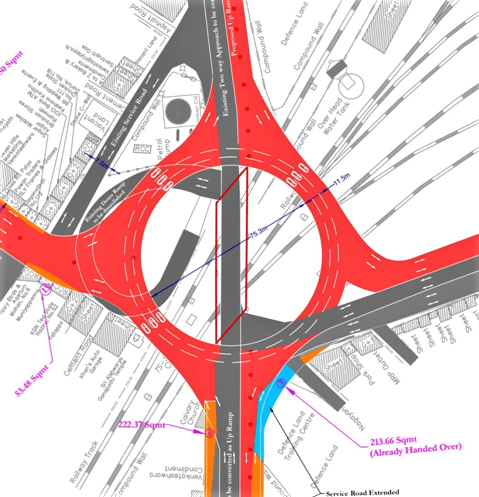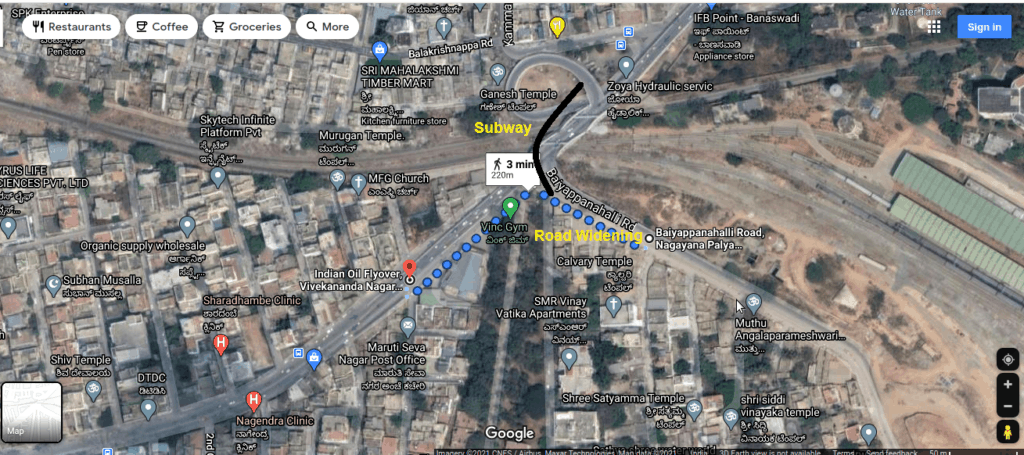The swanky new Sir M Visveswaraya railway terminal at Baiyappanahalli is due to be opened towards the end of this month. The butterfly-shaped terminal, built at around Rs 350 crore, is bound to be a transportation hub on the eastern end of the city. When operational, this terminal could take the load off the two other major railway terminals in the city: the Krantiveera Sangolli Rayanna Railway station in Majestic and Yeshwanthpur railway station.
While the terminal itself promises to be a state-of-the-art facility, its usability has many hurdles. Access and connectivity to this terminal is the main issue.
For the last four years, since work on the terminal began, citizens have raised this issue. Many came up with solutions to make the terminal accessible to users, both from the Old Madras Road side as well as from Kasturi Nagar side.
Read more: Two ideas for easy access to Baiyappanahalli Terminal
The officialdom, however, has shown no foresight in this regard. The Indian Railway Stations Development Corporation provided an overview for connectivity to the new terminal, as per the Revised Master Plan (RMP 2031). The IRSDC’s design was as follows:

BBMP’s mega plan
The Indian Railways planned this terminal way back in 2012. Work started only in 2017, and was expected to be completed by 2019. In the nine years since it was planned, neither the Urban Development Department of Karnataka nor any of the Bruhat Bengaluru Mahanagara Palike chiefs thought it necessary to give proper road connectivity to this terminal. At the same time, even the railway officials did not insist that the state government provide better connectivity.
Almost as an afterthought, the BBMP, only recently, released a mega Rs 120 crore plan to provide access to the terminal. The plan involves acquiring land from the Railways, Defence and other government agencies.
There are, however, glaring shortcomings in the BBMP’s accessibility and connectivity plan. One of its major flaws is that it does not consider access on either side of the terminal.
Both sides access absent
Providing access to the terminal from both sides is a basic requirement. As discussed by SWR and the Chief Secretary of the government of Karnataka in 2020, road access from Kasturi Nagar should be provided. There should be a 30 ft wide road through NGEF land. Commercial activity should not be allowed on this road.
All the three major railway stations in Bengaluru — City station, Yeshwanthapur station and Cantonment station — provide station access on both sides. This is key to accessibility and decongestion.
Lacks Metro connect
It is crucial to connect the new terminal to the Baiyappanahalli Metro station with a foot-over-bridge. Just like the state government’s plans at Cantonment, a FOB can be built in three months to ensure Metro connectivity is provided. This may cost Rs 15-20 Crore.
ROB needs wider lanes
The BBMP is planning to add two additional lanes to the ongoing railway-over-bridge at Baiyappanahalli, but without a sound traffic design. At two points, these expanded lanes converge into single lanes. This will choke traffic flow, as happens at the Hebbal flyover, Guruguntepalya ROB and the IOC flyover.

The BBMP should widen the roads in the ROB that is presently under construction and provide 2+2 width lanes for smooth flow on both sides. If required, some Defence land should be acquired.

Flyover challenges
The BBMP’s plan to construct a new flyover in place of the IOC flyover, above the existing railway line, will be a big challenge. This work above a railway line that has heavy rail traffic — and it will only increase after the doubling of tracks and opening of the new terminal — will be more difficult since the plan is for a rotary flyover.
Read more: What citizens must do to speed up Commuter Rail
Also, the SPV for the suburban rail project, Karnataka Rail Infrastructure Development Company (K-RIDE), has planned elevated tracks between Banaswadi and Baiyappanahalli, for the Baiyappanahalli – Chikbanawara corridor. Now, with a bigger rotary flyover, K-RIDE will have to redesign the spans to cross this bridge. This itself will be a mammoth task.
Quick remedies
Thanks to poor planning and lack of interests from officials and elected representatives, the pain of citizens in accesssing the terminal will not reduce immediately. The Rs 120 crore estimated cost could escalate and the construction could drag on for the next 4-6 years.
We have already lost precious time to build proper access and connectivity to this world class coaching terminal. At least now, the BBMP, SWR, BMRCL and UDD should plan and execute — besides creating access to both sides of the terminal and connecting it to the Baiyappanahalli Metro station — the following:
Build a subway: A subway could be built near Mukunda Theatre, to provide access from Baiyappanahalli towards Banaswadi, Kamanahalli, Kalyan Nagar and Hennur. Presently, one can reach the new terminal from these places, but cannot go back.
Local train services: Provide local train services with good frequency from Yeshwanthpur to Whitefield via Baiyappanahalli terminal.
Foot-over-bridge for ROB: Provide a foot-over-bridge at the under-construction ROB so that citizens can walk cross the railway track from Old Madras Road side and reach the new terminal.
Direct road connectivity: Provide a direct road connectivity from Banaswadi Main Road to the terminal at grade, with a width of 60 Ft, for a distance of 200 to 300 metres. This can be done at very less cost and in less than six months.

The story of Sir MV terminal
The railway terminal at Baiyappanahalli was planned way back in 2012. Efforts were made to get this station built under a PPP with Japan or China. But that did not materialize.
In 2016, the Railway Board initially sanctioned pit lines and stabling lines at the cost of Rs 115 crore. Finally, the coaching terminal was sanctioned and the foundation stone laid by the Railway Minister Suresh Prabhu in January, 2017.
Baiyappanahalli 3rd Coaching terminal was expected to be ready in 2019 after missing several deadlines. It was to have 1 lakh footfalls within a year, once full-fledged inter-city trains are operated.

It has 7 Platforms, 8 stabling lines and 3 Pit lines. This coaching terminal is at a distance of 2 Km from the existing Baiyappanahalli railway station. It is already delayed by two years, and is expected to be opened by end of February, 2021.
To provide basic connectivity to this terminal and also eliminate two level-crossings 100 meters apart, a Rs 27 crore ROB at LC gate No 136 (A) — intended to connect the terminal and Swami Vivekananda Metro station — was proposed way back in 2010 on a cost-sharing basis.
Poor planning and lack of co-ordination between BBMP and the Defence authorities brought this bridge work to a standstill in 2012. Defence land was not provided by the BBMP. In October 2019, work again restarted after Defence land was obtained.
More than 14 months since Defence land was obtained, this two-lane bridge is nowhere nearing completion. It could create its own record of 11 years under construction.
Right beside BYP metro station, there is old Byappanahalli railway station. Metro station and this old railway station are also linked via a ped bridge.
If trains are added from this old station to new terminal (to and fro) with frequency of once in 15 min or so, it can ferry people from metro station to new terminal. All that is required is a few extreme short distance trains and tracks to stop this train at the new terminal and the old BYP station.
And this can be implemented in 1 or 2 weeks at the most
This can happen only in Bangalore.
192cr spent to build a rail terminal whose access road has to be built at cost of 120cr!!
And that access road is still on papers.
God save the commuters.
Whitefield to Yesvantpur via Viswesvaraya Termilnal EMU trains with peak hour frequency 10 minute and other time 20 minute round the clock have to be provided